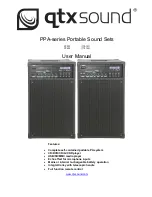
Planning
DCN design
The DCN System has three parts: the DCN network, the wireless network and the optical
network.This chapter tells how to design the DCN.
Calculation tool
The calculation tool makes the planning and design of the DCN easier. Find the calculation
tool on the DVD that is supplied with your system.
Concepts
This section gives necessary data to understand the limitations.
Trunk and tap-off sockets
The DCN uses two types of socket:
–
DCN trunk sockets: Use the DCN trunk sockets to make a loop-through in the trunk of the
DCN.
–
DCN tap-off sockets: Use the DCN tap-off sockets to make more branches in the DCN. A
DCN tap-off socket always regenerates the digital DCN signal.
Cables
Many devices used in the DCN system have a 2 m cable. If necessary the extension cable
(LBB4116) can extend the device cables.
Limits
Make sure these limits are not exceeded when you design the DCN:
Limit 1: Control capacity
–
The maximum number of active devices in a DCN that a central control unit can control is
245.
–
For the maximum number of active devices that a multi CCU can control. See Example
layouts, page 83 > Multi‑CCU system.
–
The number of passive devices is without limit (refer to Control capacity, page 66).
–
The maximum number of data distribution boards in the system is 15.
Limit 2: Power capacity
–
The maximum power that one DCN socket of the central control unit can supply is 85 W.
Refer to section Power capacity, page 67.
Limit 3: Loop-through
The maximum number of loop-throughs in succession for active devices is 25, where 4 m
additional extension cable is the equivalent of 1 active device. If there are more than 25 loop-
throughs of active units, or an equivalent mix with additional extension cable, the signal must
be regenerated with a trunk splitter (LBB4114/00).
The maximum number of loop-throughs in succession for passive devices is 50, where 2 m
additional extension cable is the equivalent of 1 passive device. If there are more than 50 loop-
throughs of active units, or an equivalent mix with additional extension cable, the signal must
be regenerated with a trunk splitter (LBB4114/00).
In case active and passive units are mixed in the trunk line, all units need to be seen as active
units with their corresponding loop-through limit of 25.
Example 1: regeneration is required after using 100 m extension cable and no active or passive
devices.
4
4.1
4.1.1
4.1.2
4.1.3
64
en | Planning
Conference System
2013.11 | V2.0 | DCN-NG_OM_V4.x
Operation Manual
Bosch Security Systems B.V.
Summary of Contents for DCN Next Generation
Page 1: ...Conference System DCN Next Generation en Operation Manual ...
Page 2: ......
Page 288: ......
Page 289: ......
















































